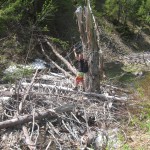Mt. Chief Pascall 2015
Date: Jan 11, 2015
Participants: Brittany Zenger, Ed Zenger, Geoff Zenger, + 4 other BCMC members
Difficulty: 3
Report: Just over three years since my previous trip to Mt. Chief Pascall, I joined Brittany on a BCMC trip that she organized to make a ski ascent and descent of the peak. We’ve had a bad snow year so far, but the trip was scheduled for a month later in the season than my previous trip and so I was optimistic that there’d be enough snow to avoid any alder bashing and have a decent run down the mountain. Luckily, someone removed the alder on the lower logging road in the past few years, but as it turned out, there was no good run down to be had.
We met up at 8:15 in Pemberton at the Mt. Currie Coffee Company and headed up to the weather station pull out on the Duffey Lake road and set out from the cars at around 9:30am. So far, so good. There wasn’t much snow in the trees and the initial creek crossing was a little interesting, but we made it up to the logging road on the opposite side of the valley without too much drama. From here we followed the logging road to the east to the far edge of the clearcut and made our way up through the trees on the far side of it as there wasn’t quite enough snow to make it up through the clearcut itself. The going was slow due to the lack of snow, but we made steady progress up to the ridge. Unlike last time, we stuck a bit too far to the right of the route indicated on Baldwin’s map, but luckily it worked out in the end. There is a bit of exposure higher up if you stick too far right and it’s definitely easier to stick to the mellow terrain to the left (i.e. if you hit some cliff bands, you should traverse left, not right), but it turns out that either way works.
Higher up the skinning became decent, and at the top of the run labelled “Equinox” on Baldwin’s map we left our skis behind and booted up to the summit. We were on the summit some time between 2 and 2:15, which means that the ascent took about 45 minutes longer than on my previous trip to the peak, but conditions were much more challenging this time around. The views to the north were great but unfortunately the view to the summit of Joffre was clouded in. Interestingly, this was the same day that 3 deaths occurred in the central couloir Joffre (partly visible from the summit of Chief Pascall) but in the winter silence nothing seemed amiss.
Now… the descent. The last time I skiied Chief Pascall the descent took approximately 2 hours (perhaps a bit less) and would’ve been much shorter than that except for a group member going off route at one point and everyone having to wait for him to reascend to the correct path. This time was another story. The snow was wet heavy cement in places, and icy with fluff underneath in others. The common element between both conditions was the simple lack of snow all around. Given the lack of snow on the ascent route we chose to descend via “Equinox” in the hopes that it would save us from some nasty conditions in the trees lower down. It didn’t. It probably wouldn’t have been better on the ascent route but the descent down to the logging road was literally the worst skiing I’ve had in my life. Hard to turn, obstacles everywhere, and impossible to ski in places due to lack of snow, it took us well past dark to make it down to the road, and we didn’t make it to the cars until about 7:20. The descent took us just shy of 5 hours and we were all exhausted! Anyways, thank you to everyone for the trip, I’m glad to have been in the area again and for the great company, but I really hope that ski conditions improve soon so that other trips this year actually have some quality skiing, unlike this one.















































































































































